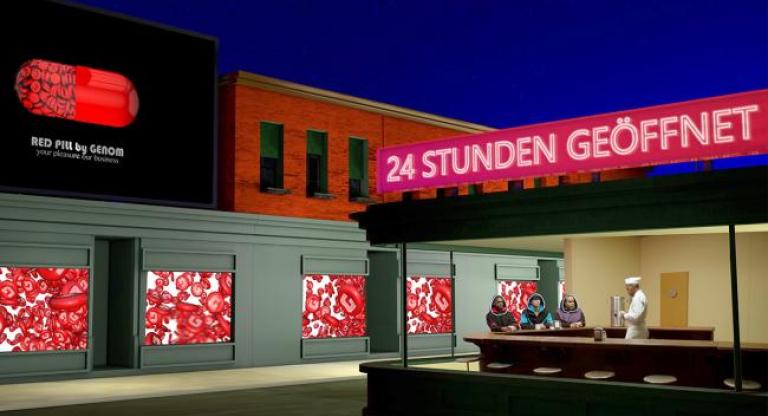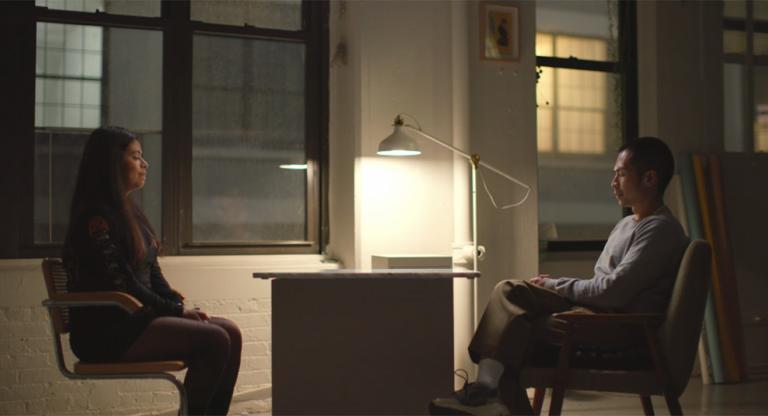The residents of San Francisco did not know that the U.S. military released the bacteria Serratia marcescens and Bacillus globigii on the city in September 1950 until a Senate subcommittee hearing over twenty years later. Operation Sea-Spray, which was intended to determine San Francisco’s ability to withstand a bioweapon attack and is documented in Shu Lea Cheang’s UKI (2009-2023), left no visible residue despite the bacteria’s capacity to generate red pigment. Yet the animated red cells, pills, and wastelands pervasive in UKI invent and become a belated sort of evidence. The experiment marks the end of the decade in which the artist Edward Hopper painted Nighthawks (1942), which Cheang digitally renders and reinvents as a meeting place for the film’s characters. Wouldn’t it be so nice, Cheang tempts us, to stay in the film’s CGI version of a mid-century American painting we know so well? Wouldn’t it be nice if we could admire and exercise the rule of thirds without the threat of biowarfare? Hopper’s image starts to feel a bit claustrophobic, even if it remains a reprieve from the chaos of the virus-ridden world engineered by the film’s GENOM Corporation.
A sequel to Cheang’s I.K.U (2000), UKI tells the story of GENOM Corporation-developed Reiko, a humanoid from the year 2060. No longer of any use, Reiko is dumped in E-Trashville, an evolved and futuristic take on the landfill from Cheang’s career-defining Fresh Kill (1994). The fictional BioNet corporation, which seeks to collect and alter people’s orgasm transaction data to produce mass-marketed pills that generate instant sexual pleasure, is at the heart of UKI and Cheang’s recent art installation Welcome to BioNet (2021). UKI works within the tradition of artists and writers like Kathy Acker and Samuel R. Delany who proffer worlds, or underworlds, where the commodification of sex is pushed to an extreme. Cheang’s project, and use of multimedia digital installation and gaming software, threatens audiences with participation. The film was completed during the recent Covid-19 pandemic, but is as much a response to the AIDS epidemic to which Cheang bore witness during her time in New York City in the ‘80s and ‘90s. If we, as Cheang has said elsewhere, “are part of a meta-integrated network surveillance structure,” UKI asks, “how do we negotiate ourselves within these systems?”
Some designate the film a “parable,” but that implies a lesson. Instead, Cheang’s developments in Sci-Fi New Queer Cinema are allegorical, in the spirit of the fragmentary, unfixed kind of allegory characterized by the theorist Walter Benjamin in Origin of the German Trauerspiel and The Arcades Project—a modality so married to the future that it could seem to deliver us from the question of history right as it doubles back around to reclaim its necessity.
Operation Sea-Spray’s bacterial cloud is local history for us who live in San Francisco or a BART ride away: it has a date and time, printed at the bottom corner of Cheang’s screen. Serratia marcescens is still present in our microbial ecology. That is not just history: it defines the matter of our present world. The virus at the end of the world was once AIDS. It was also Covid-19, particularly in U.S. prisons. It is the spread of polio in Gaza after Israel’s obliteration of its wastewater management—and subsequent obstruction of aid efforts—generating the “perfect environment for diseases like polio to spread.” Every virus is both the end of the world and, if anyone survives it, a harbinger for a subsequent one. UKI is not just allegory or parable, but a plea for action against biowarfare and those complicit.
UKI screens this Saturday, March 29, at Artists' Television Access as part of Other Cinema.






